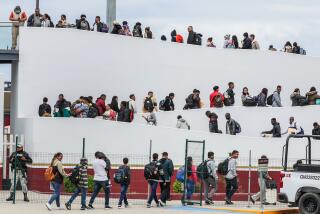Out of the Blue: Spokane Gets an Unwelcome California Jolt
Keri Yirak is skittish. Over the last six months, 91 earthquakes have struck below her old wood-frame house, rattling not only her nerves but also her finest china.
She points to the skewed sconces, the broken picture frame and the cracks in her stucco walls.
She keeps a flashlight and shoes next to her bed. She records the time and describes the motion of each trembler in a journal for scientists to review.
The seismic activity wouldn’t raise an eyebrow in Southern California, where hundreds of earthquakes are recorded weekly.
But until now, Spokane has not been considered earthquake country.
Residents have felt the rolling of large but distant earthquakes: February’s 6.8-magnitude earthquake near Olympia, Wash., and a 7.3-magnitude earthquake in 1959 near Yellowstone National Park. But for most of Spokane’s 410,000 residents, local geological uprisings are a novel experience.
“I’m starting to de-decorate,” said Yirak, 39. Three glass lampshades are now in a box, along with the antique clock that adorned the fireplace hearth and the collectibles from the china hutch.
“This is my prayer--and I don’t say it lightly: ‘God, take the anxiety and the fear and replace it with practical wisdom,’ ” she said. “I don’t want to live in fear all my life.”
The swarm began June 25 with a 3.9-magnitude jolt that was accompanied by a loud bang. Puzzled residents streamed outdoors, checking for an explosion, then went back inside to turn on TVs.
Attorney Beverly Anderson was at her desk on the top floor of Spokane’s tallest office building, 20 floors above the street. A plant in a macrame hanger began swinging, and the blinds clattered hard against the expansive windows.
“We asked the people from California what to do,” said Anderson, 42. “They told us to go to the center of the floor and to just relax. But that wasn’t easy. The building was swaying.”
Since then, quakes have come in groups: a bunch over a few days, then none for several weeks, then another geologic spasm. The strongest, a magnitude 4.0, struck Nov. 11. An earthquake of that size is felt by most people in the vicinity, causing hanging objects to swing and dishes and windows to rattle and possibly break.
There have been no injuries and only minor damage, including bricks loosened on some 70-year-old buildings downtown. Ruth Regis, 89 and a Spokane native, complained that the framed photograph of her 6-year-old grandson fell off the wall. “Californians must have sent them up here,” she said of the earthquakes. “And everyone is thinking that it might get worse. And they don’t give any warning!”
Schoolchildren practiced duck-and-cover drills beneath their desks. Homeowners strapped water heaters to walls. Earthquake experts recommended that older wood-frame homes be strapped to their foundations. With every significant shake, public works crews checked bridges, the water treatment plant and a nearby dam on the Spokane River, which flows through the heart of downtown.
Geologists are trying to locate the mystery fault that is the source of the shaking. They were handicapped from the beginning: There were no seismographs in Spokane. The nearest one, 40 miles away, was unable to accurately pinpoint the epicenters of the relatively weak Earth movements.
By early July, borrowed seismographs were placed around town--just as the swarm quieted. After they were removed and returned to scientists on another project, a bunch of earthquakes struck. Another seismograph was borrowed and installed in early August, and there was no seismic activity for six weeks. Three days after it was returned, four earthquakes struck.
“Just our luck,” said Ruth Ludwin, a University of Washington geophysicist assigned to the Pacific Northwest Seismograph Network.
Today, six seismographs are in place in and around Spokane. The most recent readings suggest a fault running through the middle of town, with the various epicenters concentrated below Gonzaga Preparatory School, about three miles northeast of City Hall.
The high school is built solidly of concrete, and the larger earthquakes have occurred after school hours. The 970 students will know what to do, though, if one strikes during classes.
“We get on our knees and huddle into a little ball below our desks,” said Jennifer Stokes, 16. “It’s pretty tight.” During drills, “there was some giggling.”
Because of eastern Washington’s geological history, scientists are not hopeful of easily finding visible signs of a fault. Spokane is built atop a 700-foot-deep layer of rock and gravel deposited by a flood about 10,000 years ago.
“That sediment doesn’t show any fault traces, at least none that we recognize,” said Bob Derkey, a state geologist who until recently spent most of his time mapping the state’s mining activity. “We have a lot of work to do.”
Several known faults that run through the city have not been active for tens of millions of years and are not believed to be responsible for the current cluster.
Some of the earthquakes have not been detected by the Spokane seismographs, indicating that they were not only very small but also very close--within a mile or two--to the surface. Residents have reported feeling 62 of the 91 earthquakes, said Ludwin.
Scientists are not predicting a larger quake, but they note that virtually the entire western part of the country is susceptible to a 5.0-magnitude earthquake.
“There’s definitely a seismic hazard in Spokane, the extent of which we simply don’t know,” said Ludwin. “But we know we can’t ignore Spokane any longer.”
More to Read
Start your day right
Sign up for Essential California for news, features and recommendations from the L.A. Times and beyond in your inbox six days a week.
You may occasionally receive promotional content from the Los Angeles Times.






